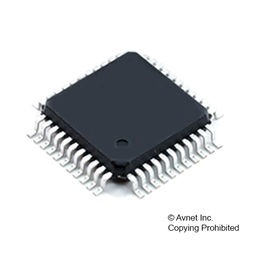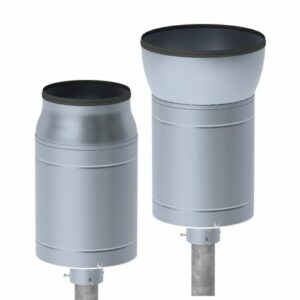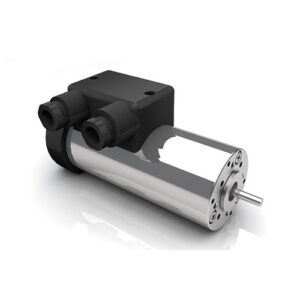Описание
PIC18LF46J13 incorporate a range of features that can significantly reduce power consumption during operation Alternate Run Modes: By clocking the controller from the Timer1 source or the internal RC oscillator, power consumption during code execution can be reduced by as much as 90%. Multiple Idle Modes: The controller can also run with its CPU core disabled but the peripherals still active. In these states, power consumption can be reduced even further, to as little as 4% of normal operational requirements. On-the-Fly Mode Switching: The power-managed modes are invoked by user code during operation, allowing the users to incorporate power-saving ideas into their application’s software design Deep Sleep: The 2.5V internal core voltage regulator on F parts can be shutdown to cut power consumption to as low as 15 nA (typical). Certain features can remain operating during Deep Sleep, such as the Real-Time Clock Calendar. Ultra Low Power Wake-Up: Waking from Sleep or Deep Sleep modes after a period of time can be done without an oscillator/clock source, saving All of the devices in the PIC18F47J13 family offer five different oscillator options, allowing users a range of choices in developing application hardware. These include: Two Crystal modes, using crystals or ceramic resonators. Two External Clock modes, offering the option of a divide-by-4 clock output. An internal oscillator block, which provides an 8 MHz clock and an INTRC source (approximately 31 kHz, stable over temperature and VDD), as well as a range of six user selectable clock frequencies, between 125 kHz to 4 MHz, for a total of eight clock frequencies. This option frees an oscillator pin for use as an additional general purpose I/O. A Phase Lock Loop (PLL) frequency multiplier available to the high-speed crystal, and external and internal oscillators, providing a clock speed up to 48 MHz The internal oscillator block provides a stable reference source that gives the PIC18F47J13 family additional features for robust operation Fail-Safe Clock Monitor: This option constantly monitors the main clock source against a reference signal provided by the internal oscillator. If a clock failure occurs, the controller is switched to the internal oscillator, allowing for continued low-speed operation or a safe application shutdown. Two-Speed Start-up: This option allows the internal oscillator to serve as the clock source from Power-on Reset (POR), or wake-up from Sleep mode, until the primary clock source is available
- Power Management Features with nanoWatt XLP for Extreme Low Power:
- Deep Sleep mode: CPU Off, Peripherals Off, SRAM Off, Currents Down to 9 nA and 700 nA with RTCC:
- Able to wake-up on external triggers, programmable WDT or RTCC alarm
- Ultra Low-Power Wake-up (ULPWU)
- Sleep mode: CPU Off, Peripherals Off, SRAM On, Fast Wake-up, Currents Down to 0.2 µA, 2V Typical
- Idle: CPU Off, SRAM On, Currents Down to 1.7 µA Typical
- Run: CPU On, SRAM On, Currents Down to 5.8 µA Typical
- Timer1 Oscillator w/RTCC: 0.7 µA, 32 kHz Typical
- Watchdog Timer: 0.33 µA, 2V Typical Flexible Oscillator Structure:
- Two External Clock modes, Up to 48 MHz (12 MIPS)
- Integrated Crystal/Resonator Driver
- Low-Power 31 kHz Internal RC Oscillator
- Tunable Internal Oscillator (31 kHz to 8 MHz, ±0.15% Typical, ±1% Max.)
- Precision 48 MHz PLL or 4x PLL Options
- Low-Power Secondary Oscillator using Timer1 @ 32 kHz
- Fail-Safe Clock Monitor (FSCM):
- Allows for safe shutdown if any clock stops
- Programmable Reference Clock Output Generator Peripheral Highlights:
- Peripheral Pin Select:
- Allows independent I/O mapping of many peripherals
- Continuous hardware integrity checking and safety interlocks prevent unintentional configuration changes
- Hardware Real-Time Clock/Calendar (RTCC):
- Provides clock, calendar and alarm functions
- High-Current Sink/Source 25 mA/25mA (PORTB and PORTC)
- Four Programmable External Interrupts
- Four Input Change Interrupts
- Three Enhanced Capture/Compare/PWM (ECCP) modules:
- One, two or four PWM outputs
- Selectable polarity
- Programmable dead time
- Auto-shutdown and auto-restart
- Pulse steering control Peripheral Highlights (cont.):
- Seven Capture/Compare/PWM (CCP) modules
- Two Master Synchronous Serial Port (MSSP) modules featuring:
- 3-wire SPI (all 4 modes)
- SPI Direct Memory Access (DMA) channel w/1024 byte count
- I2C™ Master and Slave modes
- 8-Bit Parallel Master Port/Enhanced Parallel Slave Port
- Three Analog Comparators with Input Multiplexing
- 12-Bit Analog-to-Digital (A/D) Converter module:
- Up to 13 input channels
- Auto-acquisition capability
- 10-bit mode for 100 ksps conversion speed
- Conversion available during Sleep
- High/Low-Voltage Detect module
- Charge Time Measurement Unit (CTMU):
- Provides a precise resolution time measurement for both flow measurement and simple temperature sensing
- Supports capacitive touch sensing for touch screens and capacitive switches
- Two Enhanced USART modules:
- Supports RS-485, RS-232 and LIN/J2602
- Auto-wake-up on Start bit
- Auto-Baud Detect (ABD) Special Microcontroller Features:
- 5.5V Tolerant Inputs (digital only pins)
- Low-Power, High-Speed CMOS Flash Technology
- C Compiler Optimized Architecture for Re-Entrant Code
- Priority Levels for Interrupts
- Self-Programmable under Software Control
- 8 x 8 Single-Cycle Hardware Multiplier
- Extended Watchdog Timer (WDT):
- Programmable period from 4 ms to 131s




